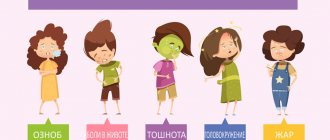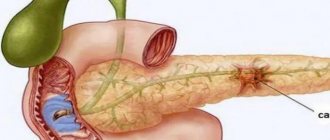Juicy watermelon is rightfully considered one of the healthiest delicacies: it is perfectly refreshing in the heat, quenches thirst and cleanses the kidneys of uric salts. Watermelon pulp contains a large amount of useful substances: antioxidants, vitamins, microelements. Nutritionists recommend including this huge berry in the menu of fasting days for overweight people, nursing mothers (to increase lactation) and everyone without exception to improve digestion processes. Unfortunately, in addition to useful “pros”, there are also some “cons”. One of them is the possibility of poisoning. What should you do to avoid trouble? What are the symptoms of watermelon poisoning in an adult? What about the child? About this and much more in our article today.
Causes of poisoning
The “watermelon” season “opens” in July and lasts until approximately September. When buying watermelon, each of us probably wondered: “Does it have nitrates?” Nowadays they write and talk a lot about the harmful effects of nitrates on our body. For many, the word “nitrates” has become synonymous with poison, but why is nitrate poisoning most often associated with watermelons?
Interesting fact: it turns out that watermelons are not “nitrate” record holders. 1 kilogram of watermelon contains about 60 mg of nitrates. But in beets, spinach, celery, cabbage - up to 1000 mg per kilo. The smallest amount of saltpeter is found in peppers, onions, green peas and eggplants. For reference: WHO considers a harmless daily dose of nitrates to be 220 mg per day.
Content
- Types of food poisoning
- Signs and symptoms in children
- Causes of food poisoning in children
- What should you do if you are poisoned?
- Peculiarities of child nutrition after treatment
- Disease prevention
Food poisoning is a complex of painful symptoms that occur when the body is affected by poisonous and low-quality products of animal or plant origin. Toxins can enter in different ways: through the intestines, absorption through the mucous membrane of the nasopharynx, or inhalation. In children under one year of age, absorption and distribution throughout the body occurs faster. Source: H.D. Abdikhakimovich Features of the course of foodborne toxic infections // Pediatrician, 2022, v. 8, special issue
Poisoning in children is more common than in adults, and its course is much more complicated. This is explained by the peculiarity of the child’s still fragile body. In the early years, the intestinal microflora is not yet formed, toxins are quickly absorbed and spread through the blood, and low acidity of gastric juice is noted.
What are nitrates?
Nitrates are salts of nitric acid, better known to us under the name “saltpeter”. Nitrates are part of the human body, plants and soil and in acceptable concentrations do not cause significant harm to health.
High concentrations of these substances are hazardous to health. Nitrate poisoning occurs more often after eating early vegetables, herbs, watermelons, melons and fruits, so doctors do not advise getting carried away with the fruits of the first harvest.
Nitrate poisoning leads to disruption of the nervous system, heart, digestive organs and tissue hypoxia. However, saltpeter is not the only “culprit” of food poisoning. The fact is that when the peel is damaged, various microbes penetrate into the watermelon, causing an intestinal infection.
How does nitrate poisoning manifest?
Nitrates are used as fertilizers for rapid plant growth and fruit ripening. But if the watermelon is not yet ripe, the nitrates do not have time to be processed and end up in the stomach. A small amount of nitrates will not harm a healthy adult, but severe intoxication can occur if the digestive system is malfunctioning or in childhood. And if there are a lot of nitrates in watermelon, no one can avoid poisoning.
When nitrates are retained in the body, they combine with hemoglobin. The result is methemoglobin, which is unable to carry oxygen. The result is oxygen starvation (hypoxia). Nitrate poisoning can cause reactive pancreatitis and exacerbation of chronic diseases.
The following signs indicate nitrate poisoning:
- The skin and mucous membranes turn pale, become bluish, and in severe poisoning - purple.
- Hands and feet are cold.
- Pulse is weak.
- My head is spinning.
- Convulsions may occur.
- Nausea, vomiting, and diarrhea appear.
- There are pains, cramps and colic in the abdomen.
- The most dangerous symptoms are yellowing of the whites of the eyes, bitterness in the mouth and fainting.
During the off-season, the risks of buying a watermelon full of nitrates are much higher, but even in August you should carefully inspect the fruit before purchasing and eating it.
The following signs indicate that the watermelon is not ripe:
- Watermelon with nitrates will not crack when squeezed.
- A good watermelon should have a dry stem and a clear yellow spot on the side - a sign that the fruit has been lying on the ground for a long time and ripened. In a “nitrate” watermelon, the spot may be absent or white.
- Inside, the fruit of an “unhealthy” watermelon is riddled with thick yellow veins. The color of the pulp may be too bright and even have a purple tint.
- The pulp of a good fruit should be “sugar” when cut, and a “nitrate” watermelon should be smooth when cut.
- If you dip a piece of pulp into water and it turns bright pink, you have a “nitrate” watermelon.
Symptoms of bacterial poisoning
Bacteria penetrate into the watermelon pulp through holes or multiply in it as a result of spoilage of the product.
Symptoms are similar to other food poisoning:
- Nausea appears, leading to vomiting.
- There is discomfort, seething, and gas formation in the intestines.
- Diarrhea develops.
- Blood pressure decreases and pulse slows.
- Body temperature rises.
- Headache.
- There is pain in the abdomen in different places.
- Weakness and chills occur.
- Aching joints.
To avoid poisoning from spoiled watermelon, it is important to follow the following rules:
- You need to purchase the aromatic delicacy away from roads and only in reliable places where there is a canopy. Fruits should be stored on racks.
- The peel of the fruit should be intact, there should be no holes or cuts on it. Do not buy already cut fruits and do not ask the seller to cut the watermelon to check its ripeness.
- Watermelon should not be soft.
- Smell the fruit; it should not have a sour smell.
- Remember that you can store sliced watermelon in the refrigerator for no more than 1-2 days.
First aid for watermelon poisoning
To eliminate intoxication, you should rinse the stomach until there are no more food impurities in the vomit, but only rinsing liquid. You can be treated with enterosorbents (Enterosgel). Another common question: if you are poisoned by watermelon, what should you take for dehydration? The answer is simple: rehydron, weak tea, water.
What medicine from your medicine cabinet can harm watermelon poisoning? What should not be taken: antipyretics and antibiotics. Treatment is necessary for diarrhea, uncontrollable vomiting, convulsions, blood in the stool, impaired consciousness, if watermelon poisoning does not reduce symptoms in pregnant women, and also if a person has a very high body temperature. In such cases, the patient is hospitalized in a hospital, where intoxication is eliminated and water-salt balance is restored.
What are the risks of watermelon poisoning during pregnancy?
It has already been said above that vomiting and frequent bowel movements are constant signs of watermelon poisoning in a victim. These symptoms quickly lead to dehydration of the expectant mother. Impaired water balance not only harms a woman, but also increases the risk of miscarriage. The female body loses electrolytes and vitamins necessary for the normal development of the fetus.
What to do if you are poisoned by watermelon?
You need to see a doctor! Do not self-medicate!
Diet features
Watermelon food poisoning requires following a strict diet. In the first hours after the onset of symptoms, it is better not to eat; it is enough to replenish lost fluid with water. Some doctors recommend refusing to eat on the first day, trying to eat no earlier than 24 hours later, and giving preference to vegetable broth or rice water. It is allowed to use rosehip decoction, weak tea, and jelly.
For several days you need to eat the following dishes:
- low-fat meat broths - a secondary broth is required, the first water after boiling must be drained;
- porridge with water - rice, oatmeal, buckwheat (cereals need to be well boiled);
- steamed poultry cutlets;
- steam omelette or hard-boiled eggs.
On the 4th-5th day from the onset of the disease, you can introduce lean meat and fish, dried bread.
It is necessary to refuse fatty varieties of poultry, meat, fish, pickles and marinades, smoked meats, spicy dishes, sauces, baked goods, and confectionery products. You should also not eat dairy products, brown bread, raw vegetables and fruits. When it comes to porridges, it is better to avoid millet and barley cereals; they are less digestible.
On the question of whether it is possible to eat watermelon if poisoned or eat other fresh berries: no, it’s not worth it. Fresh vegetables, fruits, and berries contain fiber, which can irritate the inflamed mucous membranes of the stomach and intestines.
Enterosgel and food poisoning
The fact is that Enterosgel absorbs toxins and bacteria. It quickly and easily passes through the digestive tract without damaging the mucous membranes and without disturbing the normal intestinal microflora. Enterosgel reduces the severity of poisoning by absorbing the products of secondary inflammation and metabolic disorders. Enterosgel is also prescribed to treat the consequences of food poisoning: dysbiosis, liver and kidney dysfunction.
Treatment of food poisoning at home involves replenishing fluid lost through diarrhea and vomiting. At home, after each bowel movement or bout of vomiting, you should take about a glass of liquid in small sips after each vomiting and bowel movement.
If the patient does not have diarrhea, a laxative should be added to Enterosgel to speed up the removal of toxins from the intestines.
If the symptoms have not gone away several hours after food poisoning, then you need to call an ambulance.
Treatment at home can have negative consequences for the child’s health, so it is better to contact a doctor immediately! The child needs to drink plenty of fluids to avoid dehydration and get rid of intoxication.
What can't you do at home? You should not give your child anti-diarrhea medications or analgesics.
When food poisoning occurs in a severe form, the child develops:
- dyspnea;
- heartbeat;
- convulsions;
- streaks of blood in the stool;
- decreased blood pressure;
- yellowness of the skin and sclera.
Pediatricians advise not to ignore the listed symptoms in children and to promptly seek medical help.
As a rule, after a few days you feel better and the functioning of all body systems is gradually restored. During this period, it is mandatory to follow a diet. You can eat easily digestible foods: slimy porridges and soups, vegetable and fruit purees, but fatty and fried foods should be excluded from the menu.
Is it possible to eat watermelon after full recovery? Of course you can! Especially, being careful and remembering what is written above.
Features of treatment
Treatment of watermelon poisoning is possible at home only if the condition does not cause concern. You can cope with mild intoxication using the following measures:
- Gastric lavage. To do this, you can use warm salted water or a weak solution of potassium permanganate. It is necessary to drink a large amount of liquid and induce vomiting by pressing with your fingers on the root of the tongue. The procedure must be repeated until clean water comes out.
- Reception of sorbents. After washing, you can take sorbents; they will absorb toxic substances and prevent their absorption into the bloodstream.
- Drink plenty of fluids. It is important to replenish fluid lost due to vomiting and diarrhea and speed up the elimination of toxins with water.
Painkillers, antidiarrheals and antiemetics are usually not prescribed for mild poisoning. The body will cope with poisoning on its own, and it is not worth depriving it of its natural mechanisms for getting rid of excess. Such drugs can be prescribed by a doctor only in case of uncontrollable vomiting, persistent diarrhea, high risks of dehydration and electrolyte disturbances.
Sorbents will help relieve symptoms and speed up recovery. One such product is Fitomucil Sorbent. It contains the shell of Psyllium plantain seeds - this component absorbs toxic substances and removes them from the body naturally. Psyllium is a natural soluble fiber that quickly absorbs water, turns into a soft gel and removes excess without irritating the intestinal mucosa. The composition also includes the prebiotic inulin, which stimulates the growth of beneficial microflora. The double action allows you not only to quickly cope with the symptoms of poisoning, but also to restore normal microflora after diarrhea.
Causes of illness in a child
One of the main causes of food poisoning is the consumption of stale food . To avoid illness, you should pay attention to the appearance and smell of food, as well as storage conditions. Often, parents buy food for their child without paying attention to the expiration date. Even if you make purchases at a trusted retail outlet with an impeccable reputation, you must always look at the packaging of the product.
In addition to low-quality products, in medical practice there are cases of chemical poisons and toxic plants entering the baby’s body along with food. Toxins may be contained in medications or household chemicals that the child used accidentally or unknowingly.
Peculiarities of child nutrition after treatment
During recovery, the child is prescribed a diet that is similar to the diet for any intestinal infections. Children are recommended:
- increasing the frequency of meals up to 6-8 times a day;
- drinking liquid, crushed and pureed food in fractional portions;
- exclusion of fried foods;
- ad libitum feeding (give food on demand, but do not overfeed).
The main rule of nutrition is that food should contain a minimum amount of fat. You should avoid whole milk, fruits and fresh baked goods, which can cause fermentation in the intestines. You can give more boiled water, crackers, low-fat cottage cheese, baked apples, cookies, rosehip decoction.
Useful properties of watermelon
Watermelon is a large berry, most often oval, cylindrical or spherical in shape. Watermelon is extremely low in calories - there are only 25 calories per 100 grams of product, which makes it attractive to those who are on diets or are fans of a healthy diet. Watermelon contains an impressive amount of vitamins, as well as a high content of potassium, calcium, magnesium, iron, sodium and phosphorus.
The main thing is to make the right choice
It has the following beneficial properties:
- Thanks to the dietary fiber contained in watermelon, metabolism is normalized.
- This berry contains fructose, which is a fruit sugar that is excellent for feeding people with diabetes.
- Watermelon has pronounced diuretic and choleretic properties, and is known as a liver and kidney cleanser.
- Has the ability to reduce blood cholesterol levels.
However, despite all the benefits of watermelon, it can also be dangerous. This fruit absorbs nitrates well, which can cause poisoning.
In addition, it should be used with caution by people suffering from allergies or kidney failure; in case of diabetes, watermelon consumption is allowed in small quantities.
What to do if a large berry causes an intestinal upset?
When is medical help needed?
If you are poisoned by watermelon, you should call a doctor in the following situations:
- uncontrollable vomiting or diarrhea that does not decrease over several hours, despite the measures taken;
- excessively high temperature that does not decrease throughout the day;
- confusion, loss of consciousness;
- convulsions;
- blood in vomit or stool;
- the appearance of shortness of breath;
- age up to 12 years;
- pregnancy.
Medical care is aimed at replenishing the water-salt balance, detoxifying the body, and maintaining the functions of vital organs (heart, liver, kidneys).
Signs and symptoms in children
Food poisoning in children occurs suddenly and manifests itself in an acute or mild form. The first signs are observed several hours after the child has consumed spoiled or poor quality food. Often this happens within 60 minutes, with a latent course of the disease – up to 8 days. The faster the symptoms of poisoning appear, the more dangerous it is.
Regardless of the pathogen, stomach poisoning in children may result in:
- cutting pain in the abdomen;
- general weakness and lethargy;
- the presence of nausea and/or vomiting;
- chills;
- dry mucous membranes;
- pale skin;
- increased or decreased temperature;
- loss of appetite;
- increased thirst;
- rapid breathing and pulse;
- loose stool.
The greatest danger to a baby's health is vomiting and loose stools , since they can quickly dehydrate the body and can cause kidney failure. The main signs of dehydration include: a decrease in the frequency of urination and a decrease in the amount of urine, dry skin and a decrease in its elasticity.
In difficult cases, botulism may occur with damage to the nervous system. With such poisoning, the baby experiences dry mouth, constipation, and visual acuity may decrease.
If a child is poisoned by plants, he is most often bothered by severe abdominal pain with profuse drooling. There may be changes in heart rate and rhythm disturbances.
Mushroom poisoning is characterized by painful sensations in the abdomen, pallor of the lips and skin, and upset stool. The child may experience nausea and frequent vomiting, sometimes with blood. Poisoning with poisonous mushrooms is the most dangerous type of poisoning.
Eating vegetable dishes and foods high in nitrates can cause a number of symptoms in a child. These include pain in the stomach, lethargy, headache, shortness of breath, gagging and tinnitus.
Symptoms of poisoning that require prompt medical attention:
- low body temperature;
- dyspnea;
- drowsiness;
- dark colored urine and a decrease in its quantity;
- blood in vomit or stool.











